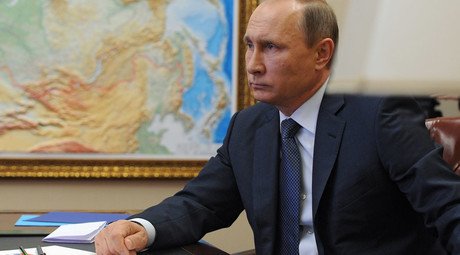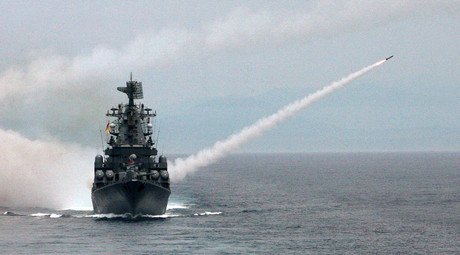Downed in 17 seconds? Where Turkey’s story of Su-24 violating airspace just doesn’t add up
A Russian Su-24M tactical bomber performing a combat sortie over the territory of Syria in the vicinity of the Turkish border was brought down by a Turkish Air Force fighter jet. Ankara and Moscow have conflicting versions of what exactly happened on Tuesday.
LIVE UPDATES: Russian warplane shot down at Syria-Turkey border
Ankara claims the Russian Su-24 frontline bomber was downed after it violated Turkish airspace. The alleged violation reportedly lasted 17 seconds. The Russian military says the jet never entered Turkish territory and the Turkish F-16 fighter itself breached Syrian airspace.
Airspace violation contested
According to an official narrative that Turkey hastily put forward, its F-16 fighter jets intercepted two “unidentified” aircraft as they were approaching the Syrian-Turkish border. Both had reportedly violated airspace above Turkish territory in the south and one of them was shot at while in Turkish airspace. To back up its claim, Turkey released a flight map of the incident.
#BREAKING Pentagon spox confirms Turkey warned Russian pilots repeatedly before shootdown, pilots did not respond pic.twitter.com/DiKUWmdPWn
— CNN Türk ENG (@CNNTURK_ENG) November 24, 2015In a letter to the UN, which was leaked online, Turkey claimed it had warned the bomber 10 times in five minutes before the F-16s fired air-to-air missiles. The letter says that the plane spent 17 seconds inside Turkish airspace before it was taken down.
Turkey's statement: Claims Russia violated airspace for just "17 seconds" with very slow 243 miles/hour jet. pic.twitter.com/knhdy0RWIA
— WikiLeaks (@wikileaks) November 24, 2015The Russian Ministry of Defense denied any communication attempts on behalf of Turkey before the incident.
It said the downed Su-24 had never entered Turkish airspace, demonstrating a flight track contradicting that released by Ankara. The ministry added that the Su-24 was shot down over the Syrian territory about 1km from the border and crashed 4km from it.
#SYRIA#Rudskoy Objective monitoring data confirmed no attempts of Turkish plane to establish communication or visual contact with Rus crew
— Минобороны России (@mod_russia) November 24, 2015The Russian military said that the Turkish F-16 jet that shot down the Russian warplane had entered Syrian airspace in order to attack in an act that violated Syria’s sovereignty.
Previous incidents
Russia and Turkey have previously had disagreements over Russian military jets flying close to the Turkish border. In early October, a Russian warplane briefly entered Turkish airspace in what the Russian military later said an evasive maneuver taken in response to a Turkish fighter jet locking on the Russian plane.
Ankara protested and Russia apologized for the mistake, which appeared to be the end of the conflict.
“We’ll warn any country that violates our borders in a friendly way. Russia is our friend and neighbor. There is no tension between Turkey and Russia in this sense. The issue of Syria is not a Turkish-Russian crisis,” Turkish Prime Minister Ahmet Davutoglu said at the time.
Even if Turkey’s version of what happened on Tuesday is true, the response to alleged violation by Russia appears to be disproportionate and contradicting Ankara’s own position. In 2012, Turkey lost an F-3 Phantom warplane to a Syrian attack after it strayed into Syrian territory.
“A short-term border violation can never be a pretext for an attack,” President Recep Tayyip Erdogan, who was then-Turkish prime minister, told BBC at the time as he expressed rage over the downing of the plane.
And Turkey has prior form in terms of violating other nations’ airspace. In 2005, Turkey entered Greek airspace 1,017 times, or as often as 40 times a day, according to a WikiLeaks document.
Russia’s anger over the incident is aggravated by the fact that it happened shortly after Moscow signed an agreement with Washington on how to prevent such incidents over Syria, where both Russian warplanes and aircraft of the US-led coalition conduct anti-terrorist missions. Turkey is part of the American coalition and is subject to the agreed rules.
Russian Su-24M jet shot down by Turkey over SyriaTurkey shoots down Russian Su-24 fighter jet over Syria. Turkey says it violated airspace, Russia denies. READ MORE http://on.rt.com/6xe7
Posted by RT Play on Tuesday, November 24, 2015
Complaining to NATO
One of Turkey’s first moves following the incident was to call its NATO allies while stonewalling Russia’s requests for communication, according to the Russian Defense Ministry. The alliance expressed support for its member.
“We stand in solidarity with Turkey and support the territorial integrity of our NATO ally, Turkey,” NATO Secretary-General Jens Stoltenberg said after the emergency meeting.
But Ankara’s explanations to fellow alliance members were reportedly not that convincing.
“A number of representatives of member countries of the alliance reacted very cautiously to the Turkish complaints,” an insider source described the meeting to RIA Novosti.
The source added that Turkish military called not 10 times, but only twice before opening fire and that the recordings of those communications “are characterized as quite obscure.”
Flawed rules of engagement
So far the incident seems to boil down to Turkey either violating its rules of engagement or having an extremely aggressive approach to foreign warplanes. The use of force is justified in defending national borders, but usually a clear and imminent threat is required to resort to such drastic measures.
Russia and Turkey are (or at least were) friendly nations and the Turkish military would be justified in expecting that any unidentified plane approaching Turkey from Syria could be Russian. In mere minutes it decided that the “unidentified” warplanes posed a threat to Turkey and responded with lethal force. Over a 17-second violation, according to Turkey.
Considering the short timeframe, the decision to fire that missile was likely taken even before the alleged violation took place.
Turkey’s haste contrasts with the way the US-led coalition engages terrorist forces. In a recent attack on a truck convoy it sent fighter jets to drop leaflets warning about an imminent attack 45 minutes ahead.
Premeditated provocation?
According to some experts, the decision may have been taken long before the incident and the downing of the Russian warplane may have been a premeditated act on Turkey’s part.
“This airplane was not making any maneuvers to attack the territory,” former Vice Chief of Staff of the US Air Force, Lt. Gen. Tom McInerney, told Fox News. “It was probably pressing the limits, that's fair. But you don't shoot 'em down just because of that.”
“I don’t really trust President Erdogan in what he is doing,” he added. “I think it was an overly aggressive maneuver and at NORAD [North American Aerospace Defense] command region we would not use this kind of rules of engagement. That had to be preplanned.”
That time when #Turkey said violating airspace is no excuse to shoot down a plane...
#SU24#Russia#Syria
https://t.co/4cdA6wTaIA
— IN THE NOW (@INTHENOWRT) November 24, 2015There is other evidence pointing to a possible provocation. At least four different people managed to film the fall of the Russian plane from different points despite the fall taking about a minute. One may suspect that they knew beforehand that the plane would be taken down.
“It appears that the Turkish media knew about the incident beforehand. An anti-Russian spin had started on November 23 evening and the cameras were already there on the next day to film the falling Russian plane,” Vladimir Avatkov, a politics scientist specializing in Turkey studies at MGIMO, Russia’s leading foreign relations university, told Lenta.ru news website.
Classified US cable: Turkey violating Greek airspace 40 times a day https://t.co/iboxOyFJIwpic.twitter.com/YKFmyJZkSf
— WikiLeaks (@wikileaks) November 24, 2015The incident resulted in the deaths of two Russian troops – one of the pilots and a marine killed in an attack on a Russian helicopter sent to rescue the two pilots of the Su-24 bomber.
Russia’s relations with Turkey have taken a heavy blow, with Moscow accusing Ankara of aiding and abetting terrorists to protect revenues from oil smuggling in collusion with Islamic State. Russian President Vladimir Putin has called the incident a “stab in the back.”
LISTEN MORE:














